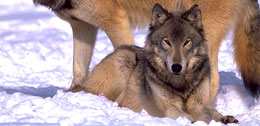|
Domtar Inc. wants to build a primary logging road to access Block 770 in the White River Forest. The road (identified as Road 770) will extend across the northern boundary of the park, bisecting an extensive wilderness corridor. Studies in the park have indicated that the road will cut through the territories of 4 of the 7 wolf packs known to straddle the park boundary. Nearly half of the park’s wolf population will be threatened by this road. Roads fragment habitats, facilitate the spread of alien species and open up areas that were previously remote to hunters, trappers and ATV users.
The Pukaskwa wolves are a unique population because they are a genetically isolated enclave of gray wolves within Eastern Canadian wolf range. Since wolves are rarely entering the park from surrounding Eastern wolf territory, wolf mortality due to the new logging road cannot be compensated for by immigration. Research has shown that the Pukaskwa wolf population has been declining and that 47% of wolf deaths can be attributed to humans. Outside the park's borders, wolves can be hunted and trapped.
Only 3% of Ontario is a sanctuary for wolves
Pukaskwa is the only National Park in Ontario that is a large enough
size to support a sustainable wolf population. Since very few protected
areas in this province are off-limits to hunting and trapping and
a large enough size, wolves are only protected on 3% of
their range in Ontario. Protection in a large wilderness
area like Pukaskwa will be rendered futile if this government does
not address the immediate threats this logging road will have on
the ecological integrity of the park.
Loss of wolves in Pukaskwa National Park will fundamentally
change the ecosystem and its long term sustainability forever.
Wolves indicate the health of an ecosystem
As a “top of the food chain” predator, wolves have a ripple effect on the whole ecosystem. Protecting wolves would help ensure that the ranges and ecological requirements of many other species are protected as well. Wolves are recognized as a “keystone” or “umbrella” species because their presence or absence from an ecosystem has such a profound impact on all other components in the intricate web of life. Since summit predators are sensitive to changes in the food chain, monitoring and conserving wolf populations is important for ensuring environmental sustainability.
In his last report, the Provincial Auditor recommended the Ministry of Natural Resources to use indicator species and their habitat requirements to better monitor ecological conditions.
|
 |
|
|
 |
Noted wolf biologist, L.D. Mech stated that "wolves can hear as far as 6 miles [9.6 kilometres] away in the forest and ten miles [16 kilometres] away on the open tundra.
Learn More About Wolves 
|
|
|
|
 |